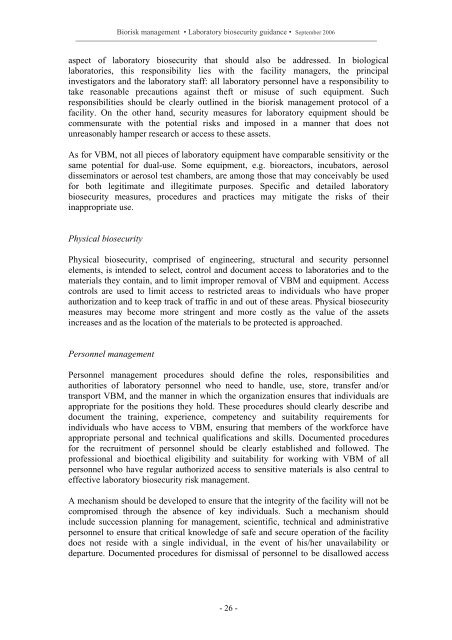Laboratory biosecurity guidance - World Health Organization
Laboratory biosecurity guidance - World Health Organization
Laboratory biosecurity guidance - World Health Organization
Create successful ePaper yourself
Turn your PDF publications into a flip-book with our unique Google optimized e-Paper software.
Biorisk management • <strong>Laboratory</strong> <strong>biosecurity</strong> <strong>guidance</strong> • September 2006<br />
aspect of laboratory <strong>biosecurity</strong> that should also be addressed. In biological<br />
laboratories, this responsibility lies with the facility managers, the principal<br />
investigators and the laboratory staff: all laboratory personnel have a responsibility to<br />
take reasonable precautions against theft or misuse of such equipment. Such<br />
responsibilities should be clearly outlined in the biorisk management protocol of a<br />
facility. On the other hand, security measures for laboratory equipment should be<br />
commensurate with the potential risks and imposed in a manner that does not<br />
unreasonably hamper research or access to these assets.<br />
As for VBM, not all pieces of laboratory equipment have comparable sensitivity or the<br />
same potential for dual-use. Some equipment, e.g. bioreactors, incubators, aerosol<br />
disseminators or aerosol test chambers, are among those that may conceivably be used<br />
for both legitimate and illegitimate purposes. Specific and detailed laboratory<br />
<strong>biosecurity</strong> measures, procedures and practices may mitigate the risks of their<br />
inappropriate use.<br />
Physical <strong>biosecurity</strong><br />
Physical <strong>biosecurity</strong>, comprised of engineering, structural and security personnel<br />
elements, is intended to select, control and document access to laboratories and to the<br />
materials they contain, and to limit improper removal of VBM and equipment. Access<br />
controls are used to limit access to restricted areas to individuals who have proper<br />
authorization and to keep track of traffic in and out of these areas. Physical <strong>biosecurity</strong><br />
measures may become more stringent and more costly as the value of the assets<br />
increases and as the location of the materials to be protected is approached.<br />
Personnel management<br />
Personnel management procedures should define the roles, responsibilities and<br />
authorities of laboratory personnel who need to handle, use, store, transfer and/or<br />
transport VBM, and the manner in which the organization ensures that individuals are<br />
appropriate for the positions they hold. These procedures should clearly describe and<br />
document the training, experience, competency and suitability requirements for<br />
individuals who have access to VBM, ensuring that members of the workforce have<br />
appropriate personal and technical qualifications and skills. Documented procedures<br />
for the recruitment of personnel should be clearly established and followed. The<br />
professional and bioethical eligibility and suitability for working with VBM of all<br />
personnel who have regular authorized access to sensitive materials is also central to<br />
effective laboratory <strong>biosecurity</strong> risk management.<br />
A mechanism should be developed to ensure that the integrity of the facility will not be<br />
compromised through the absence of key individuals. Such a mechanism should<br />
include succession planning for management, scientific, technical and administrative<br />
personnel to ensure that critical knowledge of safe and secure operation of the facility<br />
does not reside with a single individual, in the event of his/her unavailability or<br />
departure. Documented procedures for dismissal of personnel to be disallowed access<br />
- 26 -

















